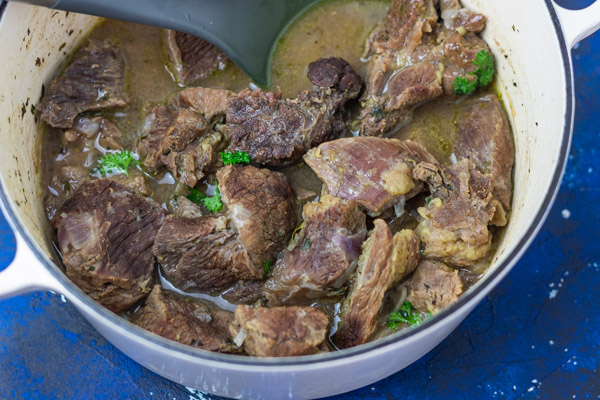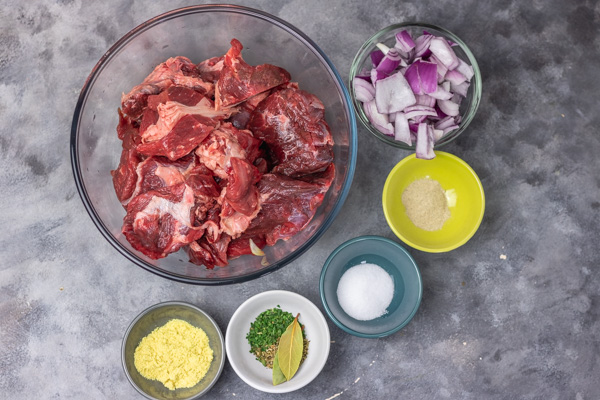Boiling beef to achieve fork-tender results may seem like a simple cooking technique, but there are some key factors to consider for optimal texture and flavor. This comprehensive guide will provide tips on choosing the right cut of beef, recommended cook times, proper simmer temperatures, and more to help you master the art of boiling beef.
Choosing the Right Cut
The first important step is selecting a beef cut that is naturally high in collagen and fat marbling. The long, moist heat cooking method of boiling gently breaks down connective tissues in tougher cuts. Here are some of the best options
-
Chuck roast This flavorful shoulder cut contains a lot of collagen and becomes fall-apart tender when boiled due to its high connective tissue content.
-
Brisket: Brisket is another collagen-rich choice that excels with moist heat methods. Look for a first cut brisket which will be the most tender.
-
Short ribs: Meaty short ribs are ideal for boiling, allowing the fat and connective tissue to melt into the cooking liquid over time. Go for English-style short ribs with the bone in for maximum flavor.
-
Oxtail: With very high collagen levels, oxtail becomes succulently tender when boiled low and slow.
-
Shank: Both front and back shanks have abundant connective tissue and make excellent boiled beef.
-
Cheeks: This underrated cut turns melt-in-your-mouth tender thanks to its high collagen levels.
Seasoning for Flavor
Don’t forget to generously season the beef before cooking for the best flavor. Good options include:
- Fresh or dried herbs: Thyme, rosemary, parsley, bay leaves
- Whole peppercorns
- Aromatic vegetables: Onions, garlic, carrots, celery
- Spices: Coriander, fennel, cloves, allspice berries
- Salt
Maintaining Proper Simmer Temperature
To maximize tenderness and flavor extraction when boiling beef, keep the liquid at the ideal gentle simmer temperature of 185°F to 205°F. This low temperature range allows the collagen and fat to slowly break down over time without the meat drying out.
Recommended Cook Times
The boiling time required can vary greatly depending on the specific cut. Here are the approximate cook times to boil different beef cuts until fork tender:
- Chuck roast: 2-3 hours
- Brisket: 3-4 hours
- Short ribs: 2-3 hours
- Oxtail: 3-4 hours
- Shank: 2 1/2 – 3 1/2 hours
- Cheeks: 2-3 hours
The exact time needed will depend on the size, thickness and age of the cut, as well as whether it is grass-fed or grain-fed. Older, grass-fed beef generally takes longer than young, grain-fed beef. Use a meat thermometer and boil until the internal temperature reaches 200°F-205°F.
Monitoring Water Level
It’s crucial to keep the beef fully submerged in liquid at all times during boiling to prevent it from drying out. Periodically check and top up the water level with boiling water as needed to maintain the original level. The water will reduce significantly over the long cooking time.
Skimming Fat and Impurities
As the beef cooks, fat, scum and impurities will float to the top of the cooking liquid. Use a spoon or ladle to skim these off periodically, especially during the first hour, for a clearer broth. Skim a few times throughout the boiling process.
Adding Vegetables
For a complete boiled dinner, add vegetables like carrots, potatoes, turnips or cabbage during the last 30-60 minutes so they cook through without becoming mushy. Cut all vegetables to a similar size for even cooking.
Checking Doneness
Use a fork or skewer to test the beef in several spots. The meat should have a very tender, buttery soft texture when done but not be falling apart. Or insert a meat thermometer to check for an internal temperature of at least 200°-205°F when the collagen will have fully melted.
Removing Done Pieces
With large cuts like brisket, the outer portions may become tender before the center is finished. When testing reveals some sections are ready early, transfer those pieces to a plate to keep warm while allowing the rest to finish cooking so the tender meat doesn’t overcook.
Separating the Meat and Broth
Once cooked, use a slotted spoon to transfer the beef to a platter. Strain the leftover cooking broth through a fine mesh strainer to remove any solids. Use the flavorful strained broth as a base for soups, gravies or stews.
Serving Suggestions
Fork-tender boiled beef stands on its own accompanied by mustards, horseradish or other condiments. It also shines in various dishes:
- Sandwiches – Slice or shred for sandwiches
- Tacos – Dice or shred for tacos, nachos, empanadas or tamales
- Hash – Chop or slice to make hash with potatoes and onions
- Roast dinner – Pair with roasted or mashed potatoes and vegetables
- Pies – Use as a filling for pot pies, meat pies or hand pies
- Soups – Add to beef barley, minestrone or vegetable soup
The soft texture also makes boiled beef an easy filling for dumplings, pierogies, ravioli or cannelloni.
Storage
Allow boiled beef to cool completely before storing in an airtight container in the fridge for 3-4 days. It can be frozen for up to 6 months. Chill and skim fat from the broth before refrigerating and freezing.
By following these tips on choosing the right cut, cooking times, temperatures, testing doneness and more, you’ll be able to achieve fork-tender boiled beef with amazing texture and flavor every time. Master the art of boiling beef for tender, juicy results.

How to boil meat (Boiled beef)
Wash and rinse the meat under cold water, remove any visible fat (I like to leave some fat on the meat as it makes the stock and the beef flavourful. Add the washed meat to a clean pot.
Place the meat on low-medium heat, add chopped onions, salt, stock powder, white pepper, oregano, parsley and bay leaves. Stir to combine, add ⅓ cup of water, cover the pot with a lid and simmer for 10 minutes.
Check on the meat, add 1 cup of water, stir to combine then continue to cook on medium heat until the meat is tender to your liking. Depending on the quantity, size and the cut of meat you use, the beef should be fully cooked at about 30 minutes in total.
NOTE: You do not need a lot of water for this recipe, meat produces its own liquid, adding too much water would just water down the flavour of the overall dish.
Separate the meat from the stock and use as desired in dishes. You can also fry or grill it for a healthier option.

Both the boiled meat and beef stock can be stored in the fridge for up to 5 days. Make sure it is completely cooled before storing
Store it for up to 3 months or longer in the freezer.

What is in my beef seasoning
I prefer using simple spices and herbs to my beef or poultry, I still want to be able to taste the flavour of the meat without the spices or herb interfering.
For my beef seasoning, I have used the following
Onion: I used red onion but you can also use yellow onion or the combination of the two.
Dried oregano and parsley: these two herbs would not alter the taste of the meat. If anything they make it flavourful and you can still taste the meat.
White pepper: don’t worry about too much heat as the recipe only calls for a little. You can use this according to preference
Stock powder (bouillon powder): you can use either chicken or beef stock cubes or powder. I am using chicken stock powder for this recipe
Bay leaves
Salt to taste: I recommend starting with 1 teaspoon for 1 kg of meat if you would be using stock cubes or powder.

How to boil meat perfectly (TENDER MEAT and RICH STOCK)
FAQ
How much time does beef need to boil?
General Boiling Time Guidelines
Beef Stew Meat: 1.5 to 2 hours. Chuck Roast: 2.5 to 3 hours. Brisket: 3 to 4 hours. Sirloin: 1 to 1.5 hours.
How long to boil beef until it falls apart?
-
Quorahttps://www.quora.comHow long does beef have to simmer in a soup until it is tender? – QuoraMar 6, 2020 — * James Romanow. Long time cook and gourmand Author has 9.6K answers and. · 5y. My rule of thumb is 3 to 4 hours on a low simmer. You can dissolve a…
-
Seasoned Advicehttps://cooking.stackexchange.comStewing beef – how long is too long? – Seasoned Advice – Stack ExchangeNov 20, 2012 — Secondly choose your meat – hard working muscles will develop more fibre so need slow cooking to break then down but that will also release the flav…
How do you know when beef is boiled?
Pierce the thickest part of the meat with a fork or skewer and check that: The juices run clear. It is piping hot all the way through (it should be steaming)
Does beef get softer the longer you boil it?
Does Beef Get More Tender the Longer You Cook It? Yes and no. It might seem counterintuitive, but tough cuts of beef get more tender with longer cooking times, while tender cuts of beef become more tough the longer you cook them.
How long does it take to boil beef?
A generous portion of beef chunks. The broth is boil for at least three hours with the beef bones. Nice and friendly staff. The other dishes like big plate chicken and fried eggplant are really delicious. Will recommend to friends and family. This review is the subjective opinion of a Tripadvisor member and not of Tripadvisor LLC.
What is the best way to heal a boil?
Boil drawing salve is an effective method for boil healing. Boils in many instances are perfectly harmless. In fact, boils is a common condition. There are many treatments available to relieve the irritation associated with boils.
How long does boiled ground beef take to cook?
Cooking time for boiled ground beef is under 20 minutes, making it simple and quick to prepare. The meat is juicy, tender, and flavorful. It can be used in bolognese, stews, tacos, pasta, and curries as well as eaten on its own. Learn how to boil ground beef in simple steps. Fill the pot with enough water to fully cover the meat.
